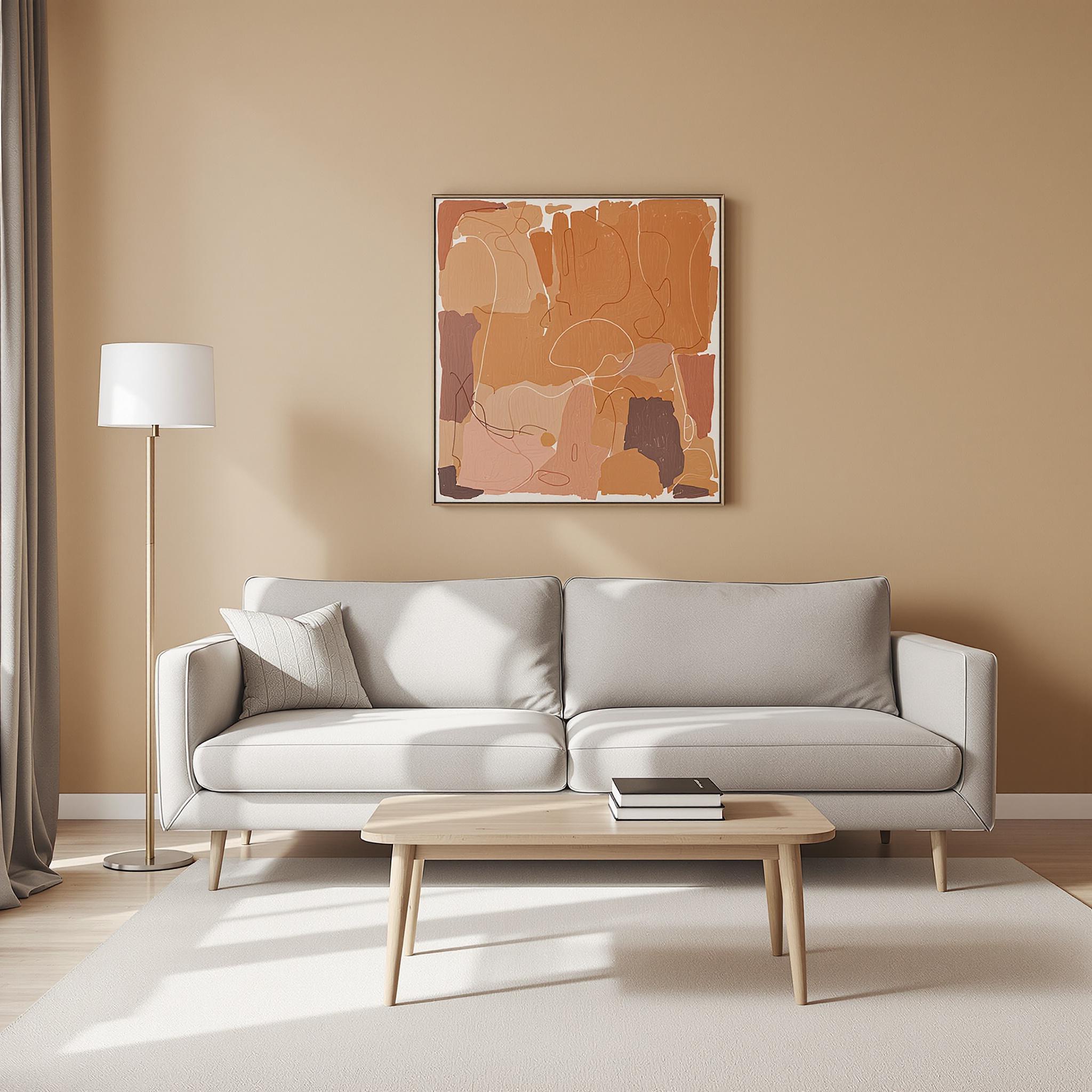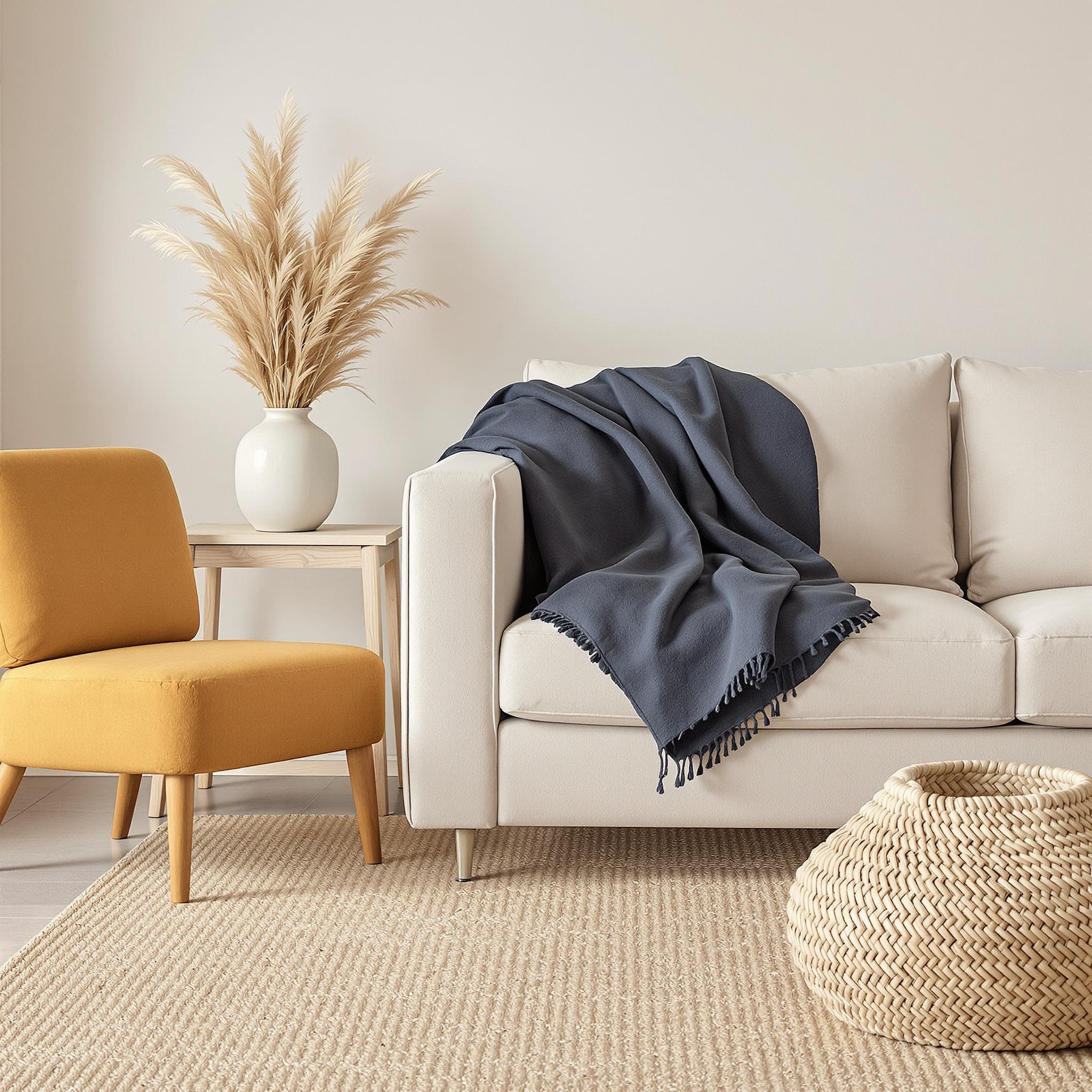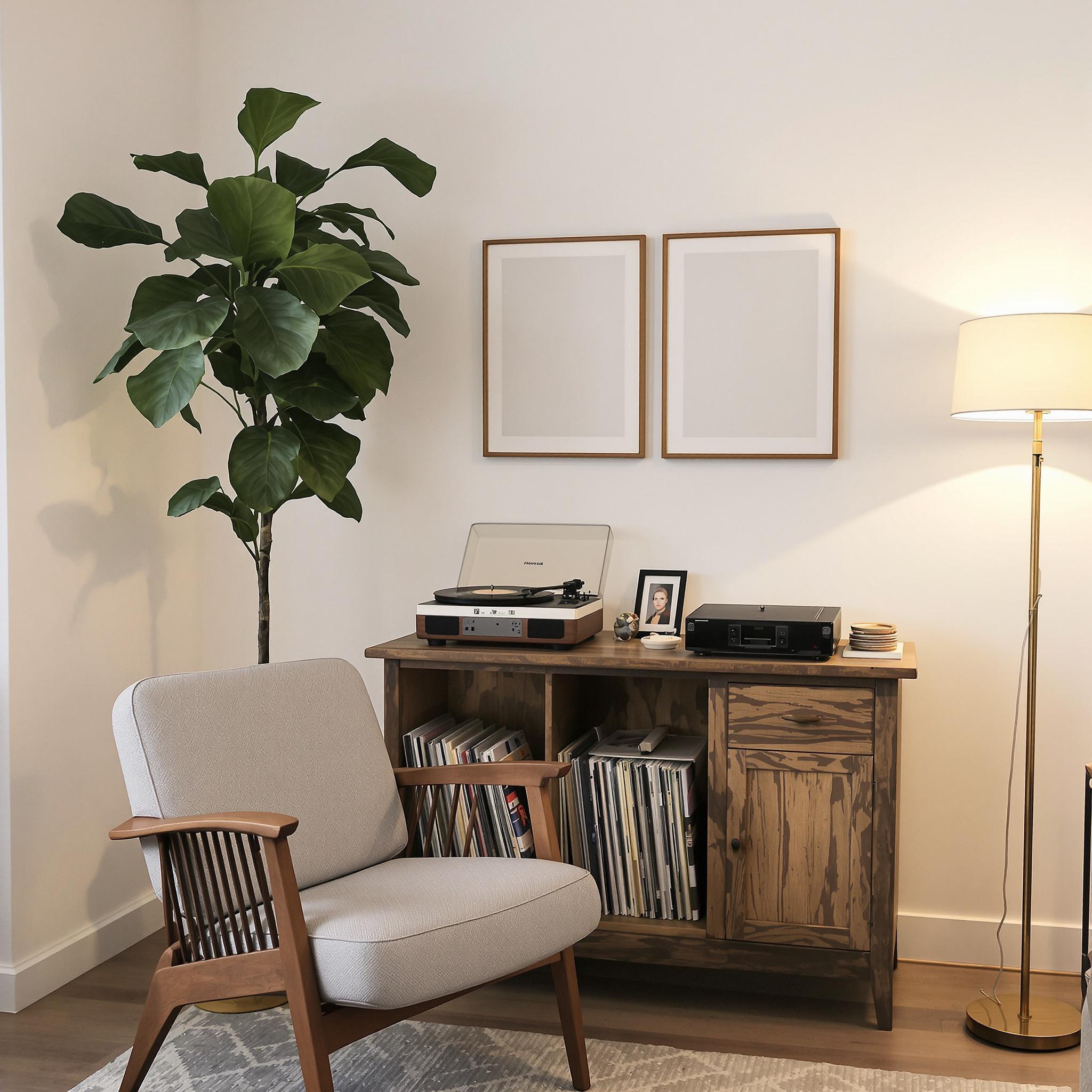What is Minimalism in Interior Design?
Minimalism strips design down to essentials. It focuses on clean lines and open spaces. The goal is clarity, not clutter.
Imagine a room with just a couch, coffee table, and lamp. No knick-knacks or piles of books. This approach calms the mind. I once helped a friend redo her living room. She kept only items she truly loved. The result? A peaceful space that felt bigger.
Minimalism isn’t about deprivation. It’s about making room for what matters most. Every piece should have purpose. If it doesn’t add value, it goes.
Key Principles of Minimalist Living Room Design
Three core ideas guide minimalist design: simplicity, functionality, and intentional decor. Let’s break them down.
Simplicity: Keep designs clean and uncluttered. Avoid busy patterns or flashy colors. Neutral tones work best. Think whites, grays, and earthy hues.
Functionality: Every item should serve a purpose. A chair must be comfortable. Storage should solve problems. Decor needs meaning.
Intentional Decor: Choose pieces carefully. Less is more. One striking art piece can say more than ten small ones. My own living room has one bold painting above the sofa. Guests always notice it.
- Stick to a few key colors.
- Prioritize quality over quantity.
- Avoid overcrowding surfaces.
These principles create balance. They make rooms feel inviting, not empty.
Psychological Benefits of a Minimalist Living Room
A minimalist space helps your mind relax. Clutter triggers stress. When you remove distractions, peace follows.
Think about how you feel in a tidy room versus a messy one. In my old apartment, piles of magazines made me anxious. Once I cleared them out, I could breathe easier.
Fewer objects mean fewer decisions. You don’t waste energy managing stuff. Instead, focus shifts to rest and connection.
Studies show organized spaces boost mood. Simple surroundings encourage mindfulness. You stay present instead of overwhelmed.
Minimalism also fosters creativity. Empty walls and open floors let ideas flow freely. Inspiration finds room to grow.
Practical Benefits of Minimalist Living Rooms
Besides mental perks, minimalism offers real-world advantages. Cleaning becomes faster. Dusting takes minutes, not hours.
With fewer things, maintenance costs drop. Broken gadgets? Lost remotes? Gone. Repairs cost less time and money.
Space feels larger too. Open layouts trick the eye. A tiny room looks airy without bulky furniture. My sister lives in a studio apartment. Her minimalist setup makes it cozy, not cramped.
Storage stays manageable. Built-in shelves hold only essentials. Everything has its place. No digging through drawers for lost items.
Energy flows better in clear spaces. Traffic patterns improve. Moving around feels natural, not awkward.
How Minimalism Creates Calm and Maximizes Space
Clutter competes for attention. Minimalism removes this noise. Your eyes find rest where there’s less to see.
Empty areas act as visual pauses. They give your brain a break. Try sitting in a room with bare walls. Notice how calming it feels.
Maximizing space goes beyond size. Smart furniture choices help. Ottomans with storage hide blankets. Foldable chairs save room.
Lighting plays a role too. Bright lamps highlight key spots. Shadows disappear. Rooms feel warm and welcoming.
Balance is key. Too much emptiness feels cold. Add soft textures like rugs or throws. These keep warmth alive.
Common Misconceptions About Minimalism Debunked
Some think minimalism means boring or sterile. Not true. It’s about thoughtful choices, not blandness.
Another myth? Minimalism equals poverty. But high-quality items often cost more upfront. Investing pays off long-term.
People worry it’s hard to maintain. Actually, upkeep is simpler. Fewer items mean less to clean or organize.
Others believe it suits only modern styles. Wrong again. Minimalism adapts to any aesthetic. Farmhouse, industrial—it works everywhere.
One final note. Minimalism doesn’t ban personality. Display cherished photos or heirlooms. Just do so thoughtfully.
Choosing a Neutral Color Palette and Incorporating Subtle Accents
Let’s talk color. Specifically, how to nail that minimalist look without your place feeling like a hospital waiting room. Neutrals are key here. Think soft grays, warm beiges, creamy whites, or muted earth tones. These shades keep things calm but still let personality peek through.
I once painted my walls stark white thinking it’d scream “minimalist chic.” Spoiler: it just felt cold. What saved it? Adding small pops of color—like throw pillows, art, or one standout furniture piece. A mustard yellow chair or navy rug can add depth without overwhelming the room. Stick to one or two accent colors max. More than that risks clutter.
Don’t forget texture. It’s a game-changer with neutrals. A chunky knit blanket or woven jute rug adds layers of interest. These touches keep things cozy instead of sterile.
Selecting Functional Furniture with Clean Lines and Multi-Purpose Uses
Now, onto furniture—the real stars of a minimalist living room. When picking pieces, ask yourself: does this do something useful? Minimalism isn’t just about looking sleek. It’s about making every item earn its keep. Go for clean lines and simple shapes. Think sleek sofas, no-fuss coffee tables, and chairs that don’t demand attention.
Pro tip: choose multi-purpose furniture whenever you can. I bought a storage ottoman once. Best decision ever. It gave me extra seating *and* a spot to stash blankets. Other smart picks include sofa beds for guests, nesting tables, or bookshelves with hidden storage.
Scale matters too. Big furniture can swallow a room, while tiny pieces might leave it feeling empty. Aim for balance. Measure twice—or three times—before buying. Trust me, realizing your dream sectional won’t fit is a nightmare.
The Role of Negative Space and How to Embrace It Effectively
Now, let’s tackle negative space. That’s the empty area around objects. It’s what makes minimalism work so well. Negative space gives your eyes a break, creating calm and order. But it’s not just empty—it’s purposeful emptiness.
Picture a coffee table with only a vase of fresh flowers. That openness makes the flowers pop. Without it, they’d get lost in the clutter. I used to fill every surface with knick-knacks because I thought it looked “homey.” Spoiler: it didn’t. Once I embraced negative space, my living room went from chaotic to peaceful overnight.
To master this, edit ruthlessly. Look at your shelves, tables, and walls. Do you really need all those items? Probably not. Keep only what sparks joy—or serves a clear purpose.
Incorporating Textures and Natural Materials for Warmth and Depth
We’ve got neutrals, functional furniture, and negative space down. Now, let’s add warmth. And no, I’m not talking about turning up the heat. Texture and natural materials are your secret weapons. They bring life to a pared-back space.
Try materials like wood, stone, rattan, or linen. A wooden side table, stone fireplace, or rattan basket can instantly elevate the room. My favorite trick? Mix textures. Pair a smooth leather couch with a nubby wool throw. Or layer a sisal rug under a plush one. The contrast keeps things interesting.
Natural light helps too. If you’ve got big windows, let the sun shine in. Sheer curtains work if privacy isn’t an issue. Otherwise, go for bamboo or linen blinds. These blend seamlessly while keeping the room bright.
Plants are another great way to add texture and warmth. A fiddle-leaf fig or small succulents bring life to the room. Just don’t overdo it. Remember, less is more.
Strategic Use of Lighting to Enhance the Room’s Ambiance
Lighting deserves its own moment. Bad lighting can ruin even the best design. Good lighting transforms everything. In a minimalist room, aim for layers of light: ambient, task, and accent.
Start with ambient lighting—the main light source. Recessed ceiling lights or a simple pendant usually work. Then add task lighting for specific activities, like reading. Floor lamps or table lamps with soft bulbs are perfect. Finally, sprinkle in accent lighting to highlight features. Picture lights over art or LED strips behind shelves add drama without taking over.
I learned this the hard way when I relied on overhead lights alone. It lit the room but lacked coziness. Switching to a mix of lamps and dimmers changed the vibe completely. Movie nights felt cozier. Dinner parties felt warmer. Lesson learned: invest in versatile lighting.
Curating Meaningful Decor Pieces and Avoiding Clutter
Finally, let’s talk decor. Here’s the rule: quality over quantity. Every item should either serve a purpose or mean something to you. Random tchotchkes? Toss them. Family heirlooms or travel souvenirs? Keep them.
When placing decor, think carefully. A gallery wall of meaningful photos or art can be a great focal point—but don’t overcrowd. Leave space between frames. If you love books, organize them neatly. Maybe face a few covers outward for color.
Side note: I started using decorative boxes for small items like remotes or coasters. It keeps surfaces tidy and adds a touch of class. Win-win.
Your living room should tell your story—not someone else’s. Whether it’s a quirky sculpture from your last trip or a handmade quilt passed down through generations, let those pieces shine. Minimalism isn’t about stripping away personality—it’s about highlighting what truly matters.
Maximizing Your Minimalist Living Room: The Final Touches
When I first tried minimalist decor, I thought it was all about getting rid of stuff. Simple, right? But here’s the catch: minimalism isn’t just about taking things away. It’s about keeping what really matters. So, let’s talk about how to add those finishing touches without losing the essence of your space.
One trick that works wonders is playing with contrast. Pair sleek furniture with something raw or vintage. For example, a mid-century chair next to a rugged wooden table. This mix creates interest without going overboard. I once visited a friend who had an old record player on a glass shelf against a white wall. It wasn’t just useful—it sparked conversations every time someone walked in.
Tips for Keeping Your Space Fresh Over Time
Even the best minimalist rooms can feel dull if you don’t shake things up now and then. Here’s what I’ve learned:
- Swap accessories: Change throw pillows, blankets, or small decor items with the seasons. Keeps things fresh.
- Update lighting: Lighting makes a big difference. Try a bold floor lamp or warmer bulbs in winter.
- Edit often: Every few months, check your stuff. If you don’t love it anymore, let it go.
And don’t forget cleaning. A tidy minimalist room feels way better than one with dust bunnies hiding around. Pro tip: Use a microfiber cloth weekly to keep surfaces spotless.
Adding Personality Without Breaking the Rules
Minimalism doesn’t have to be boring. Done right, it should still feel like *you*. One way I do this is by adding travel souvenirs or handmade items. That pottery bowl from Tuscany? Perfect for holding remotes. Those macramé hangings from college? They add texture without being too loud.
I used to think personalization meant filling every inch with photos and trinkets. Now, I focus on quality over quantity. Instead of scattering family pictures everywhere, I frame one or two standout shots and display them proudly. It looks cleaner and gives each piece more meaning.
Oh, and here’s a little secret: books. Too many can overwhelm a minimalist space, but a small stack adds warmth. Just pick ones with covers that match your color scheme—or hide the busy ones behind neutral bookends.
Inspiration from Real-Life Spaces
Scrolling through Pinterest or Instagram can be both inspiring and overwhelming. But looking at well-done minimalist rooms helps. Take Scandinavian designs, for example. They nail simplicity mixed with coziness. Think light wood, soft fabrics, and muted colors.
One of my favorite examples is a NYC apartment I found online. The owner painted an accent wall navy blue and paired it with a mustard-yellow chair. The rest of the room was neutral, but those two bold choices transformed the whole vibe. It felt daring yet cohesive.
If you’re stuck, try breaking down spaces you admire. Ask yourself: What colors did they use? How did they balance textures? Where are the focal points? Once you start noticing patterns, it’s easier to apply them to your own home.
Actionable Advice You Can Start Today
Alright, here’s some practical advice you can use right now. First, declutter your coffee table. It’s probably the messiest spot in your living room. Keep only one or two items—a candle, maybe a small plant—and watch how much calmer the space feels.
Next, consider multi-functional furniture. Ottomans with hidden storage? Genius. Side tables with built-in shelves? Life-changing. These pieces keep the clean look while secretly doing double duty.
Lastly, embrace empty space. Leaving some areas bare lets the eye rest and makes the pieces you do have stand out more.
Conclusion
At the end of the day, maximizing impact in a minimalist living room comes down to being intentional. Choose pieces that mean something to you. Balance beauty with function. Keep the space alive with subtle touches like plants or mementos. Remember, minimalism isn’t about perfection. It’s about creating a space that feels peaceful, purposeful, and uniquely yours. Take a deep breath, trust your gut, and enjoy the process.
FAQs About Maximizing Impact in a Minimalist Living Room
- How do I avoid making my room feel cold? Add cozy textures like wool rugs or linen curtains. Warm lighting helps too.
- What’s the best way to incorporate art? Go for one large statement piece instead of lots of small ones. It grabs attention.
- Can I use bold colors? Yes! Stick to one or two bold accents with neutrals to keep it balanced.
- How often should I update my decor? Refresh small elements every few months to avoid monotony.
- Where should I start when decluttering? Focus on high-traffic spots like coffee tables or shelves. Clearing these makes a big difference.
- Is it okay to mix styles? Sure! Just make sure there’s a unifying element, like a shared color or material.
- How do I deal with kids’ toys? Use baskets or bins to corral toys and put them away when not in use.
- What plants work best indoors? Snake plants, pothos, or ZZ plants are low-maintenance and add greenery.
- Should I paint my walls white? White works, but soft grays, beiges, or pale blues can add a nice twist.
- How do I keep my room from looking sterile? Layer textures and add natural materials like wood or stone for warmth.



